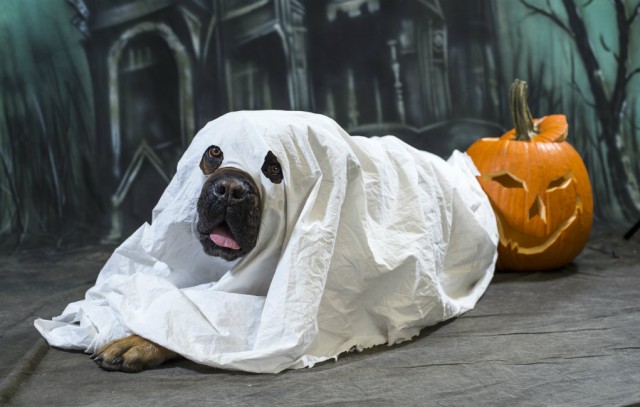
 The last Sunday of October is here. It doesn't seem possible that next Sunday will be November 1st! Did you have time to read last Sunday's column about the ingredients to look for in dog food? All week, my favorite websites and bloggers have been posting about Halloween. Halloween and dogs can be a great combination, but they can also be dangerous. This week, I decided to check out some articles and blogs about selecting a safe Halloween costume for your dog.
The last Sunday of October is here. It doesn't seem possible that next Sunday will be November 1st! Did you have time to read last Sunday's column about the ingredients to look for in dog food? All week, my favorite websites and bloggers have been posting about Halloween. Halloween and dogs can be a great combination, but they can also be dangerous. This week, I decided to check out some articles and blogs about selecting a safe Halloween costume for your dog.
It's not as easy as it seems. There are lots of factors to consider, and in the end, your dog may just not be cut out for tromping around the neighborhood in an adorable dog Halloween outfit. If your dog is agreeable to wearing a costume, you can follow this quick checklist by Jennifer Simms on 1800petmeds.com. She covers the basics really well.
- Make sure that the costume is not too tight around your animal’s neck. This can be a choking hazard. Unlike children, dogs are not able to tell you if something is too tight. Watch your pet and see if they are fidgeting or uncomfortable in their costume. Another suggestion is to place two fingers between the costume and the pet’s neck. The two-finger test is a great tool to test if the costume is too tight.
For a more in-depth list of the ins and outs of selecting a safe Halloween costume for your dog, Dr. Louise Murray, vice president of the ASPCA Animal Hospital, gave some pointers to Care.com contributor Jennifer Eberhart. Simms touches on the basics above, but many of these are common sense, and most pet owners know at least that much about selecting a canine costume.
Dr. Murray discusses some things that pet owners may not think about, including the stress a costume creates for your pet, Halloween hazards for the dog, the importance of choosing a bright-colored costume, and how vital it is to still be able to keep your pet close to you.
- Dr. Murray highlights this as one of the major factors against dressing a pet up. Watch out for any signs of stress or anxiety when you put a costume on your pet. If your pet hates her costume, don't force her to wear it! A nice orange bandana or bow tie is a happy alternative to a full-fledged costume.” If you have a pet that dislikes wearing items of clothing and acts impatient, annoyed, uncomfortable, or unhappy, it could cause serious problems for your furry friend.
I also stumbled upon an article full of great tips for selecting a safe Halloween costume for your dog in a very unlikely place – the website for Texas A&M University. The College of Veterinary Medicine and Biomedical Sciences put together a great article with some helpful tips for pet parents interested in dressing their pooch for the upcoming holiday.
- Fur-safe sprays are generally okay to use for changing the fur color as long as they are not applied too close to their eyes. Make sure that the spray is designed specifically for animal fur and that you carefully check the labels for any discrepancies.
While on their site, I also found an article about the dangers of pet Halloween costumes.
- Although costumes are a fun way to interact with your pet, Dr. Mark Stickney, Clinical Associate Professor and Director of General Surgery Services at Texas A&M University College of Veterinary Medicine & Biomedical Sciences, stressed the importance of monitoring your pet in the clothing.“Cute little costumes are fun to put on your animals while trick-or-treating, but when you are not watching your animals, make sure to take them off,” Stickney said.
Veterinary Pet Insurance (VPI) also has a great blog on its site about selecting a safe Halloween costume for your dog. Most of the other lists I found had the costume's size and fit as the number one thing to be aware of, but I thought it was interesting that VPI mentions allergies in the top spot, probably because they see a lot of pet insurance claims after pups break out in a rash in response to an allergic reaction to some type of apparel.
- It’s possible that your pet could have an adverse allergic reaction to a Halloween costume due in part to either the type of fabric or the brand of detergent or fabric softener used to clean the costume. If you notice your pet itching while wearing the costume, remove it. An allergic reaction could cause a red, itchy rash, which would then require veterinary treatment.
When it comes to pet costumes, so many pet parents go WAY overboard. This article from Banfield Pet Hospital discusses the importance of keeping it simple, and they even give you a few ideas for some really easy ways to dress your dog up without all the bows, masks, and funny hats.
- If you want to dress your dog up, keep it simple. Your dog doesn’t necessarily have to be put in a full costume. Think about a bandanna or decorative collar. These may be just the right touch. If your dog can tolerate wearing a full costume and actually likes it, pick one that fits comfortably. If it is too tight, it could cut off circulation, restrict movement, obstruct breathing, or cause sore spots. If the costume is too loose, your dog can trip or become tangled.
They also include a link to a great, short video that they made about Halloween pet safety tips.
If you're looking for some tips and tricks for the best costume for a dog, this blog has some great suggestions.
- The costume matches the dog. Like people, dogs have personalities and have a certain kind of attitude. If your Chihuahua likes to prance around and play hard to get, it might be appropriate to dress her like a bombshell heart-breaker. Short skirt, blond wig – I laugh just thinking about it. Many times, the dog reflects the owner. So, if you dress your dog like a Star Wars character, it just might be saying something about your love for sci-fi. This dog was made for that hard hat.
It goes on to show a tough-looking bulldog appropriately dressed like a construction worker. The costume looks perfect on him!
Even if you stay in on Halloween and you'd never think to dress your dog in a costume, there are still a lot of safety tips that you should be aware of to keep your Fido safe on the holiday.
Paw-rescue.org has created an excellent list of tips for dog owners who stay in and hand out candy to trick-or-treaters. It's a must-read for all pet parents who open their homes to kids on Halloween night.
- Consider crating your pet, which can make him feel more secure and reduce the chances of accidental escapes. Provide chew toys, a favorite blanket, a piece of clothing with your scent on it, or whatever comforts the animal. Play soft music or a recording of soothing sounds. If you want to have your dog near the door to greet visitors, keep him on a leash. Pets can become very stressed by holiday activities and unwelcome interruptions in routine. A nervous dog might feel threatened and growl, lunge, or bite. Keep dogs indoors. It's a bad idea to leave dogs out in the yard; in addition to the parade of holiday celebrants frightening and agitating them, there have been reports of taunting, poisonings, and pet thefts. Plus, they're likely to bark and howl at the constant flow of treat or treaters.
Halloween is actually a very dangerous time for pets. It's one of the busiest nights at emergency veterinary clinics, and it's also a common night for dogs to become lost. Likewise, it's one of the most common nights for emergency room visits due to dog bites. doggonesafe.com has a very extensive blog post that focuses on keeping pets safe and preventing dog bites on Halloween. It includes a public service announcement video, 5 Halloween safety tip videos, a list of tips for dog owners, and a list of tips for parents and children.
- Puppies and dogs that like to chase can get overly excited by costumes with dangly bits or streaming material. Supervise very carefully if you have a dog that may try to play with your children’s costumes while they are wearing them. Teach kids to be a tree and stand still if the dog starts nipping at their costume since the more they move, the more excited the dog will get.
If you do a little research before taking your pet out and about on Halloween, you're sure to have a great time. Likewise, if you'll be staying in, check out some of these resources for keeping your pet safe inside. Although Halloween is about fun, pranks, and eating candy until you get a bellyache, it's not all fun and games. Pet parents' responsibilities are never-ending, even on holidays. Have a very happy Halloween, and be safe!












